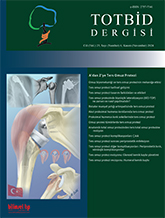
Rotator cuff tear arthropathy is defined as a clinical manifestation in which proximal migration of the humeral head, degeneration of the glenohumeral joint and rotator cuff insufficiency occurs together. The incidence increases with age and is more common in women. Patients' pain decreases during sleep and at rest. Patients often present to the hospital because they have difficulty with activities of daily living due to the combined decrease in elevation and external rotation. The morphological changes of glenohumeral joint in cuff tear arthropathy varies from superior migration of the humeral head with only regional chondromalacia to a humeral head collapse with a full-thickness cartilage defect and glenoid erosion. Direct radiographs and computerised tomography images are used in the assessment of patients. Initially, total shoulder prosthesis were used in cuff tear arthropathy patients, but these were abandoned due to the high complication rate. Later, partial shoulder prosthesis was introduced, but its use was abandoned due to instability, bone loss and limited motion in these patients. The reverse shoulder prosthesis described by Grammont was introduced. The most common complication observed in patients undergoing reverse shoulder prosthesis is scapular notching, and this complication generally has no negative impact on clinical outcomes. The most common reason for revision was originally instability, but as surgical experience and prosthesis design has evolved, this has decreased and been replaced by prosthesis infection.